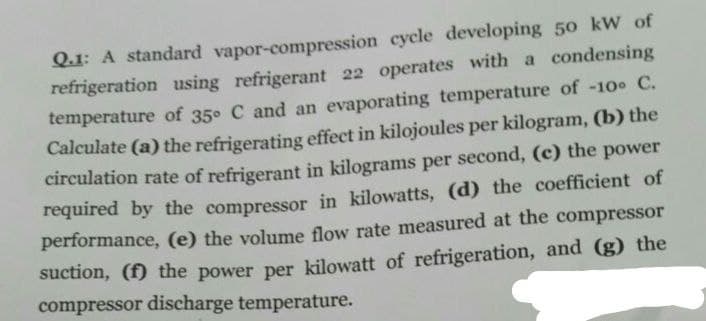Q.1: A standard vapor-compression cycle developing 50 kW of refrigeration using refrigerant 22 operates with a condensing temperature of 35° C and an evaporating temperature of -10° C. Calculate (a) the refrigerating effect in kilojoules per kilogram, (b) the circulation rate of refrigerant in kilograms per second, (c) the power required by the compressor in kilowatts, (d) the coefficient of performance, (e) the volume flow rate measured at the compressor suction, (f) the power per kilowatt of refrigeration, and (g) the compressor discharge temperature.
Q.1: A standard vapor-compression cycle developing 50 kW of refrigeration using refrigerant 22 operates with a condensing temperature of 35° C and an evaporating temperature of -10° C. Calculate (a) the refrigerating effect in kilojoules per kilogram, (b) the circulation rate of refrigerant in kilograms per second, (c) the power required by the compressor in kilowatts, (d) the coefficient of performance, (e) the volume flow rate measured at the compressor suction, (f) the power per kilowatt of refrigeration, and (g) the compressor discharge temperature.
Refrigeration and Air Conditioning Technology (MindTap Course List)
8th Edition
ISBN:9781305578296
Author:John Tomczyk, Eugene Silberstein, Bill Whitman, Bill Johnson
Publisher:John Tomczyk, Eugene Silberstein, Bill Whitman, Bill Johnson
Chapter3: Refrigeration And Refrigerants
Section: Chapter Questions
Problem 2RQ: What are the approximate temperature ranges tor low-, medium-, and high-temperature refrigeration...
Related questions
Question

Transcribed Image Text:Q.1: A standard vapor-compression cycle developing 50 kW of
refrigeration using refrigerant 22 operates with a condensing
temperature of 35° C and an evaporating temperature of -10° C.
Calculate (a) the refrigerating effect in kilojoules per kilogram, (b) the
circulation rate of refrigerant in kilograms per second, (e) the power
required by the compressor in kilowatts, (d) the coefficient of
performance, (e) the volume flow rate measured at the compressor
suction, (f) the power per kilowatt of refrigeration, and (g) the
compressor discharge temperature.
Expert Solution
This question has been solved!
Explore an expertly crafted, step-by-step solution for a thorough understanding of key concepts.
Step by step
Solved in 2 steps with 1 images

Knowledge Booster
Learn more about
Need a deep-dive on the concept behind this application? Look no further. Learn more about this topic, mechanical-engineering and related others by exploring similar questions and additional content below.Recommended textbooks for you

Refrigeration and Air Conditioning Technology (Mi…
Mechanical Engineering
ISBN:
9781305578296
Author:
John Tomczyk, Eugene Silberstein, Bill Whitman, Bill Johnson
Publisher:
Cengage Learning

Refrigeration and Air Conditioning Technology (Mi…
Mechanical Engineering
ISBN:
9781305578296
Author:
John Tomczyk, Eugene Silberstein, Bill Whitman, Bill Johnson
Publisher:
Cengage Learning